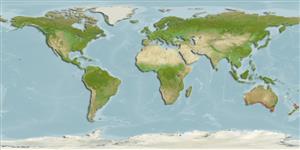Teleostei (teleosts) >
Gobiesociformes (Clingfishes) >
Gobiesocidae (Clingfishes and singleslits) > Cheilobranchinae
Etymology: Alabes: Greek, alabes, oy = a fish from the Nile, dealing with lampreys (Ref. 45335).
Environment: milieu / climate zone / depth range / distribution range
Ecology
Marine; demersal; depth range 3 - 6 m (Ref. 9002). Temperate
Southwest Pacific: Australia (Ref. 9002) and Norfolk Island (Ref. 8879).
Size / Weight / Age
Maturity: Lm ? range ? - ? cm
Max length : 5.0 cm TL male/unsexed; (Ref. 9002)
Short description
Identification keys | Morphology | Morphometrics
Diagnosis: It differs from its congeners with its elongate transparent body. Gill slit small. Rudimentary pelvic fin absent. Postocular pore 1, anterior nasal and lacrymal pores present, posterior nasal pore absent. Vertebrae total 63-74, precaudal 17-19; last epineural on the 16th -20th vertebra. Caudal rays 4-6. Gut extension short. Tail length long. Dorsal origin over the anus. Male has its anterior part of the body with tiger-like pattern of irregular reddish-brown bars which are continued onto head and break into spots, it also continue posteriorly, and break into spots; the abdominal area is bright orange to yellow with 4 large bluish black circular to rectangular blotches, arranged in a horizontal line along lower side, extending over half distance to urogenital opening (Ref. 56640).
Body shape (shape guide): eel-like; Cross section: circular.
Inhabits coastal reefs, preferably in areas with dense brown weeds. Found in small groups in 3-6 m (Ref. 9002, 56640).
Life cycle and mating behavior
Maturity | Reproduction | Spawning | Eggs | Fecundity | Larvae
Kuiter, R.H., 1993. Coastal fishes of south-eastern Australia. University of Hawaii Press. Honolulu, Hawaii. 437 p. (Ref. 9002)
IUCN Red List Status (Ref. 130435: Version 2025-1)
Threat to humans
Harmless
Human uses
Tools
Special reports
Download XML
Internet sources
Estimates based on models
Preferred temperature (Ref.
123201): 14.8 - 21.6, mean 17.6 °C (based on 332 cells).
Phylogenetic diversity index (Ref.
82804): PD
50 = 0.5005 [Uniqueness, from 0.5 = low to 2.0 = high].
Bayesian length-weight: a=0.00102 (0.00046 - 0.00225), b=3.06 (2.88 - 3.24), in cm total length, based on all LWR estimates for this body shape (Ref.
93245).
Trophic level (Ref.
69278): 3.2 ±0.3 se; based on size and trophs of closest relatives
Resilience (Ref.
120179): High, minimum population doubling time less than 15 months (Preliminary K or Fecundity.).
Fishing Vulnerability (Ref.
59153): Low vulnerability (10 of 100).
🛈
